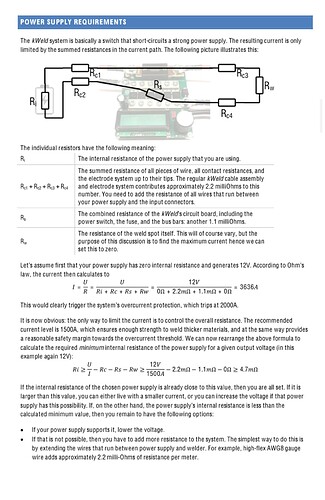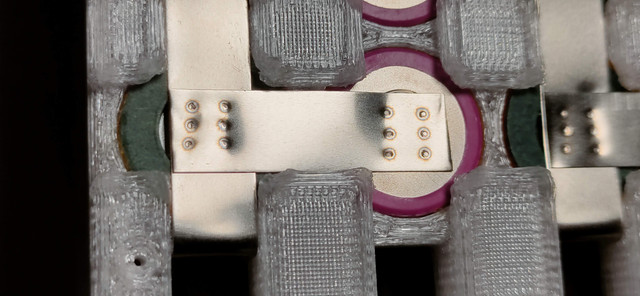I’m pretty sure @Tony_Stark had the exact same issue, maybe he can help
I had the same issue with my two turnigy graphene panther lipos in parrelel. I spoke to Frank about it and he said not to make the wires longer because the added inductance could destroy the TVS diode. He recommended to try calibration with the batteries discharged to a lower voltage, because the nickel adds resistance to the circuit during welding anyway. It worked and max I get when welding is about 1750A
Interesting the manual says to increase the cable length to add resistance.
By the sounds of it the latest battery’s by them are delivering a higher burst current than what we were gettting a couple of years ago. Not just the green graphing also some of there lower range ones as well. I suspect thay have changed the chemical compound or the internal links inside the poutches for this to be happening. My twin 6AH are only delivering 1600A these days.
That info is a bit outdated I’m afraid, as I later learned that the current limit imposed by the extra lead length (due to its extra inductance) often drops quicker than how the current drops from the added resistance. You sometimes therefore end up in a chicken-egg situation. Therefore, nowadays I always recommend to lower battery voltage and/or increase battery internal resistance instead.
I just bought a Kweld with one Kcap.
How exactly could I put 2 Kcaps in parallel ? Connect the inputs of the Kcaps together and the outputs together ?
If so how ? A rough sketch could help me get it.
Thanks
Same way you parallel 2 battery’s
Is anyone running their kweld on 2s? Some guy said he was and it was running great…, figured I would ask for more reviews on it here.
I run mine on 4s, and it works like a charm too ^^
There is a caculation in the manual 2s would need a super supply to stay in between the optimum power band and that 8.4v 1500A you woul need to have super short leads to optimise 2s
A battery has only two terminals: +ve and -ve.
Tye Kcap has 2 input terminals: +ve and -ve, in addition to two output terminals: +ve and -ve
So there is where I am confused.
I assume I have to wire the 2 outputs from each Kcap: +ve to +ve and -ve to -ve.
At the input of one of the Kcaps will be the power supply.
Shall I just leave the inputs of the other Kcap not connected to anything at all ?
I am totally guessing, but without reading any manuals or anything, i would assume it goes like this
Edited so nobody blows themself up 
If you try to charge an ultracapacitor directly from a battery, then this might end up in a blast of fire because nothing is limiting current. That’s the same as short circuiting the battery. You do need a current limiting device between them. If you have two kCap paralleled at their outputs, then you can use one input port to charge them simultaneously.
Thanks, i just need confirmation on that the other Kcap input ports remain not connected to anything at all.
It feels a bit strange to me and I hope not to blow something up.
I am indeed using the Ksupply current limiting module connected to the recommended HP power supply unit.
Just need confirmation on the configuration of parallel connection of 2 Kcaps
Hi all,
I bought a kWeld last year with 4 of those big super caps which Frank was selling separately. I get around 1300A(6awg battery cable, 8awg for probes) which for steel is enough but i have problems with 0.2 nickel and most of the time only one spot of the two is sticking. I make 3 pairs of spots weld but i am using it for commercial application and i can’t afford to have half of the welds not cooked properly.
I can rip one of the spots easily and i’m relying on the other one that “hopefully” it will stick(50J pulse). I often stack 4 layers of 0.2 nickel(one after the another) and i have to be absolutely sure that is sticking. I changed the battery cables to 6 awg which gave me a total of 1300A, i tried cleaning and maintaing a perfect shape of the tips, putting enough pressure but nothing seems to help.
I am thinking that 0.2 nickel just needs more current to cook properly, i would go to the max 2000A or even higher by shortening the probe cables and rotating the spot welder 90degree for shorter reach. It would be also nice to change the probe cables to at least 6awg(getting hot fast at 55J), but i dont know how to change them and still use the original probe holders.
If i knew from the beggining i would have bought 8 supercaps for 4s2p configuration. I dont know if Frank still has some of those caps. Another power supply ideea would be a 4s(or maybe 2s-3s) battery built with A123 lifepo4. Those can give like 120A for 10sec, i suppose 8 of those in parralel can give 2000A in a short.
https://datasheetspdf.com/pdf-file/1424845/A123Systems/ANR26650M1-B/1
I would be glad to hear some of the forum members about their experience with welding 0.2 nickel and the corresponding short circuit current needed. Is 1300A really not enough and should i invest in a stronger power supply to get 1800A-2000A (A123 supply not cheap)? I would like to hear also @tatus1969 take on this matter.
I don’t know anything about the Kweld caps or whatever, but I am able to weld 0.2 nickel just fine with my Lipo battery
You definitely could be using more than 50J though, I think on my 0.2 I welded them at 56J or a bit higher
Have you noticed the positive probe producing weaker welds with your kWeld? It seems like it plagues everyone eventually.
I don’t think I’ve noticed that really, I’ve had it stick a couple times but a quick file fixes that
Only a couple thousand welds on mine though not a ton
Yes, that’s my problem exactly.
In the beginning i didn’t notice anything strange, but i was using steel strip or thin nickel 0.1mm.
I remember that i did rip tests everytime i was using a new nickel strip and i don’t remember anything like one spot not sticking on 0.2 nickel. That was a long time ago and i barely had like 1k welds total. Nowadays i have anywhere between 10k-20k welds and this problem doesn’t let me sleep at night.
So it could be that the welder is the problem and not the 1300A power supply ?
@ShutterShock what is your welding current with Lipo?
I machined the tips (they we’re looking like new) , i checked every screw inside the welder and tightened them accordingly, i looked inside the probes (no corrosion), did many calibration, but i just cannot figure out why it’s not welding correctly.
 Nexus Boards UK - UK DIY Esk8 Supply
Nexus Boards UK - UK DIY Esk8 Supply


